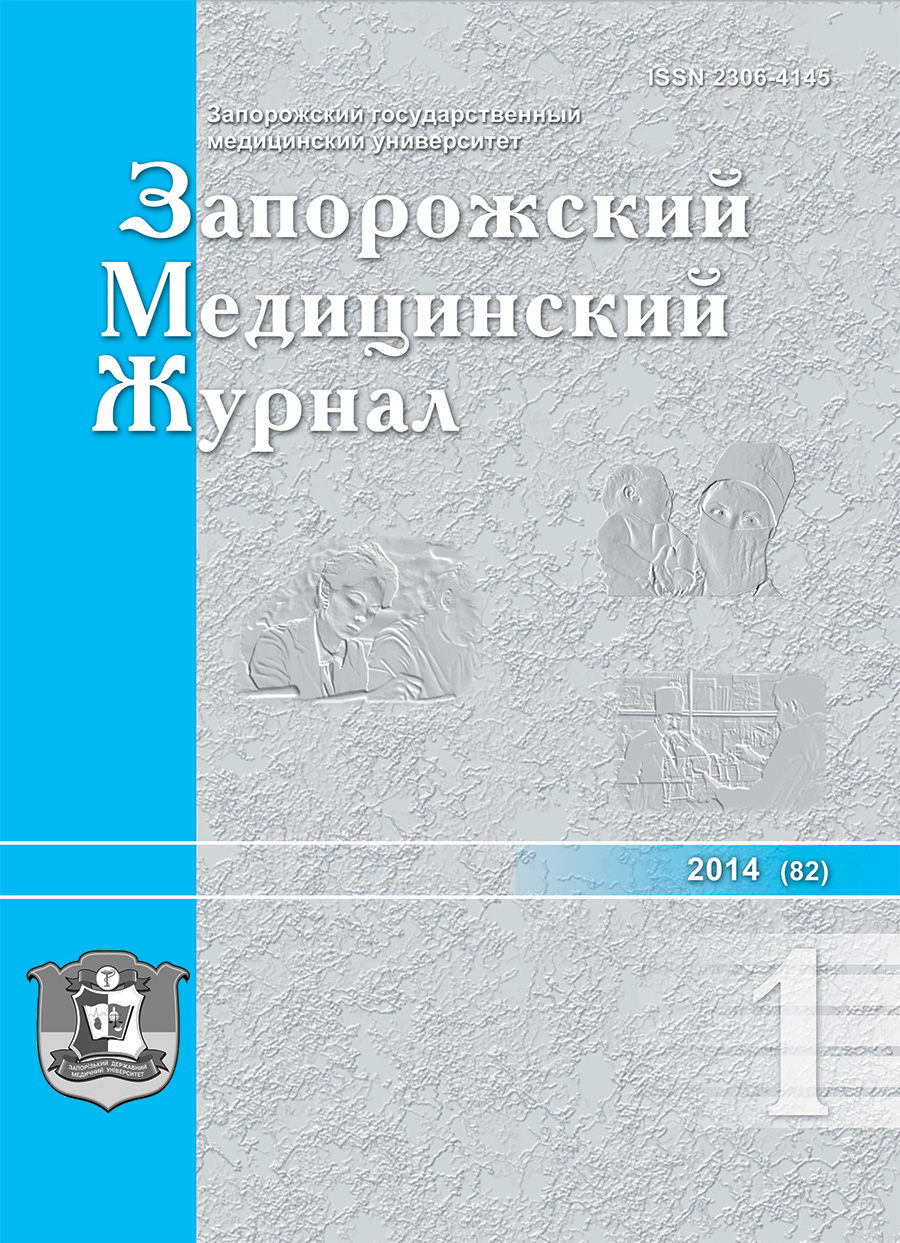Assessment of lipid metabolism in thyroid dysfunction
DOI:
https://doi.org/10.14739/2310-1210.2014.1.23657Keywords:
thyroid dysfunction, hypothyreosis, hyperthyreosis, euthyreosis, condition of lipid metabolismAbstract
1. Actuality
According to WHO Thyroid dysfunction is one of the most prevalent in humans and is one of the risk factors of cardiovascular diseases. Hypothyroidism affects the mechanisms of potentiation of cardiovascular risk factors, suggesting the need to study the level of the blood lipids in all patients with thyroid dysfunction.
2. The purpose of this study.
To define features of lipid metabolism, depending on the functional state of the thyroid gland.
3. Material and methods.
The study included 95 patients, mean age was 49,8 ± 12,9 years. 74 of them were women (78%) and 21 - men (22%). In accordance with the purpose of the work 3 groups of subjects were formed.
I-st group - 35 patients with hypothyroidism, mean age 52,5 ± 10,3 years, II-nd group - 37 patients with hyperthyroidism, the average age was 45,1 ± 13 years, III (control) group - 23 patients with euthyroid, mean age 53,9 ± 14,8 years.
Levels of TSH, triiodothyronine, thyroxine, microsomal antibodies to thyroglobulin and thyroid peroxidase were evaluated for total and biochemical analysis.
To determine the type of hyperlipoproteinemia Fredrickson, 1967 recommendations were used.
4. Results of the study
Lipid profile parameters in the I-st group compared with the control were even higher. Cholesterol increased up to 6,9% (p <0,005), Tg - 8,6% (p <0,005), β -DP - 6,8% (p <0,5), in comparison with the II-nd: cholesterol - 56% (p <0,005), TG - 55% (p <0,005) and β-PL 44% (p <0.5). In group II rates were lower than in the III- cholesterol - 8% (p <0,005), Tg 8,3% (p <0,005) and β-PL 6,5% (p <0,5).
Patients from the I-st group had the following distribution of hyperlipidemia (Fredrickson, 1967.): I type - 10 patients (29%); IIb type - 15 subjects (43%); IIa type - 9 subjects (26%); IV type - 1 patient (2%).
The correlation dependence of TSH and cholesterol (r = +0,37, p <0,05), TG (r = +0,25, p <0,05), β-PL (r = +0,74, p <0.05), TG AT (r = +0,55, p <0,05), the level of bilirubin (r = +0,29, p <0,05), thymol (r = +0, 27, p <0,05), potassium (r = +0,26, p <0,05) and females (r = +0,20, p <0,05) was detected.
5. Findings
1. Hypothyroidism is accompanied by hypercholesterolemia, elevated triglycerides, elevated levels of low-density lipoproteins and the prevalence of type II hyperlipidemia.
2. Inhyperthyroidism is a reduction in cholesterol, triglycerides and low density lipoproteins.
3. The pathology of the thyroid gland causes the need for a differentiated approach to lipid-lowering therapy, taking into account the functional state of the body.
References
Фадеев В.В. Заболевания щитовидной железы. Проблемы эндокринологии / В.В. Фадеев, Г.А. Мельниченко. – К.: Высшая наука, 2011. – С. 7–14.
Гайдаев Ю.О. Состояние эндокринологической службы Украины в 2010 г. и подходы к развязке проблемных вопросов / Ю.О. Гайдаев, Р.О. Моисеенко // Международный эндокринологический журнал. – 2011. – № 2 (8). – С. 13–17.
Ройтберг Г.Е. Метаболический синдром / Г.Е. Ройтберг. – М.: Медпресс-информ., 2006. – С. 5–11.
Паньков В.И. Практическая тиреоидология / В.И. Паньков. – М.; Донецк: издатель Заславский А.Ю, 2011. – С. 5–25.
Serum TSH related to measures of body mass. Longitudmal data from the HUNT Study, Norwey / S. Anders, N.I. Tern, E. Trine, A.O. Bjern., L. Arnulf // Clin. Endocrinol. – 2011. – Vol. 74 (6). – P. 746–775.
Особливості ліпідного та вуглеводного обміну у хворих з метаболічним синдромом та дисфункцією щитоподібної залози [Електронний ресурс] / А.О. Логвиненко, О.І. Мітченко, В.Ю. Романов Г.Я. Ілюшина, Т.В. Беляєва, І.В. Чулаєвська // Укркардіо. – 2009. – Режим доступу: http://www.ukrcardio.org/journal.php/article/381
The significance of alterations in serum lipids in thyroid dysfunction. II. Alterations of the metabolism and turnover of 131I-low-density lipoproteins in hypothyroidism and thyrotoxicosis / Walton K.W., Scott P.J., Dykes P.W., Davies J. // Clin Sci. – 2008. – Vol. 29. – P. 217–224.
Clinical relevance of thyroid dysfunction in human hacmatopoiesis : Biochemical and molecular gludies / P.M. Piotr, K. Grymuls, E. Paczkowska, M. Baskiewicz-Matuk. // Eur. J. Endocrinol. – 2010. – Vol. 162 (2). – P. 295–305.
Nikolaeva A.V. Lipid metabolism and functional status of the kidney in hypothyroid patients depending on the phase of disease / A.V. Nikolaeva, L.T. Pimenov. // Ter Arkh. – 2009. – Vol. 74. – P. 20–23.
Metabolic cardiovascular risk factors and their clustering in subclinical hypothyroidism / Ashizawa K., Imaizumi M., Usa T., Tominaga T. et al. // Clin. Endocrinol. – 2010. – Vol. 72 (5). –P. 698–695.
Duntas L.H. Thyroid disease and lipids / L.H. Duntas. // Thyroid. – 2002. – Vol. 12 (4). –P. 287–293.
Serum TSH related to measures of body mass: Longitudnal data from the HUNT Study, Norway / Svare A., Nilsen T.I. et al. // Clin. Endocrinol. – 2011. – Vol. 74 (6). – P. 769–775.
Initial thyroid status and cardiovascular risk factors: the EPIC-Norfolk prospective population study / M.S. Boekholdt, S.M. Titan, W.M. Wersinga, K. Chatterjee et al. // Clin. Endocrinol. – 2010. – Vol. 72 (3). – P. 404–410.
Riis A.L. Elevated regional lipolysis in hyperthyroidism / [A.L. Riis, C.H. Gravholt, C.B. Djurhuus et al.] // Clin Endocrinol. – 2010. – Vol. 74 (6). – P. 769–775.
Downloads
How to Cite
Issue
Section
License
Authors who publish with this journal agree to the following terms:
Authors retain copyright and grant the journal right of first publication with the work simultaneously licensed under a Creative Commons Attribution License that allows others to share the work with an acknowledgement of the work's authorship and initial publication in this journal. 

